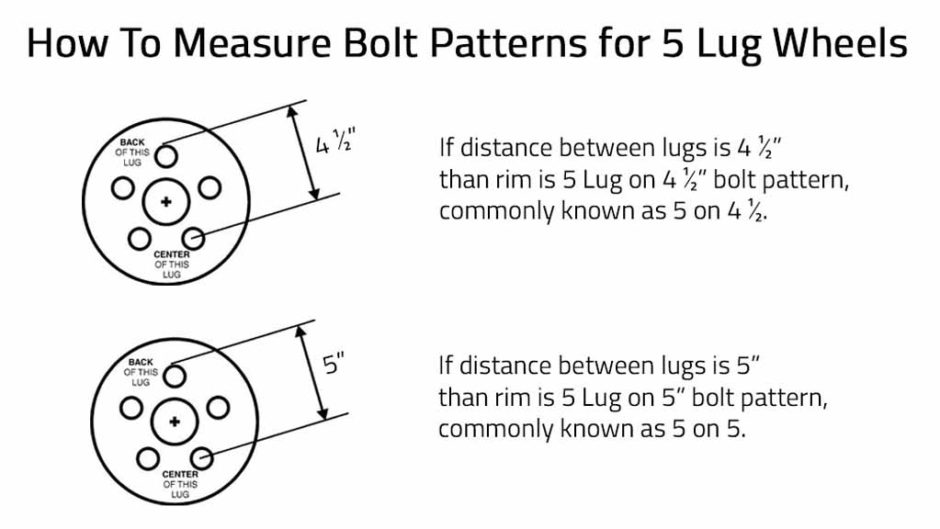Decoding Your Wheels: The Definitive Guide to Tire Rim Bolt Patterns
Ever stared at your car’s wheels, wondering about the intricate dance of bolts holding them in place? Those bolts aren't just randomly scattered; they follow a precise blueprint known as the bolt pattern. Understanding this pattern is crucial for anyone looking to replace or upgrade their wheels. It’s the key to ensuring a perfect fit, optimal performance, and, most importantly, your safety on the road.
Determining the correct wheel fitment goes beyond just aesthetics. An incorrect bolt pattern can lead to vibrations, premature wear and tear, and even catastrophic wheel failure. Think of it like trying to force a square peg into a round hole – it just won't work. Similarly, a mismatched bolt pattern can create instability and compromise the integrity of your vehicle's suspension.
So, how do you decipher this crucial code? Measuring a tire rim bolt pattern might seem daunting at first, but it's a surprisingly straightforward process once you understand the fundamentals. This guide will walk you through everything you need to know, from identifying the number of lug holes to accurately measuring the bolt circle diameter (BCD). We'll equip you with the knowledge to confidently navigate the world of wheel fitment and make informed decisions about your vehicle.
The practice of standardizing wheel bolt patterns has evolved alongside the automotive industry itself. In the early days of motoring, wheel designs were often bespoke, with little consistency between manufacturers. As cars became more mass-produced, the need for interchangeable parts, including wheels, became apparent. This led to the development of standardized bolt patterns, simplifying manufacturing and maintenance.
Accurate bolt pattern identification is paramount for various reasons. It ensures proper wheel mounting, preventing dangerous situations where the wheel could detach from the vehicle. It also allows for proper weight distribution, contributing to balanced handling and preventing uneven tire wear. Furthermore, a correct bolt pattern ensures compatibility with braking systems, preventing interference and ensuring optimal braking performance.
The tire rim bolt pattern, often referred to as the lug pattern or PCD (pitch circle diameter), is defined by two numbers: the number of lug holes and the diameter of the circle on which the lug holes are centered. For instance, a 5x114.3 bolt pattern indicates five lug holes and a bolt circle diameter of 114.3 millimeters. A simple example would be measuring a 5-lug wheel. You would measure from the center of one lug hole to the center of the lug hole directly opposite it, if one exists. If not, you measure to the outer edge of the opposite hole and double the measurement.
Benefits of accurately determining your bolt pattern include: Safety: Correct fitment prevents wheel detachment. Performance: Balanced weight distribution ensures optimal handling and tire wear. Compatibility: Enables the use of a wider range of wheels and ensures proper brake system function.
Action Plan: 1. Identify the number of lug nuts. 2. Measure the BCD. 3. Consult a fitment guide to confirm compatibility.
Checklist: Number of lugs verified? BCD accurately measured? Fitment guide consulted?
Step-by-step Guide: Count the lug nuts. Measure the BCD using a ruler or caliper. Compare your measurements with a fitment guide.
Advantages and Disadvantages of Accurate Bolt Pattern Measurement
| Advantages | Disadvantages |
|---|---|
| Safety | Requires some basic tools and knowledge |
| Performance | Can be time-consuming if unfamiliar with the process |
| Compatibility |
Best Practices: Always double-check your measurements. Consult reputable fitment guides. Use the correct measuring tools. Clean the wheel hub before measuring. Consider professional assistance if unsure.
Real Examples: A common bolt pattern for Honda Civics is 5x114.3. Many Ford trucks use a 6x135 pattern. Some older BMWs use a 5x120 pattern.
Challenges and Solutions: Rust or debris on the wheel hub can make measuring difficult. Solution: Clean the hub thoroughly. Difficulty measuring across non-opposite lugs. Solution: Use an online bolt pattern calculator.
FAQ: What is a bolt pattern? How do I measure it? What happens if I use the wrong bolt pattern? Where can I find my car's bolt pattern information? What tools do I need? Can I measure it myself? Is professional help necessary?
Tips and Tricks: Use a digital caliper for more precise measurements. Mark the lug holes with a marker for easier visualization. Consult online forums for specific vehicle fitment information. Refer to your vehicle's owner's manual.
In conclusion, understanding and accurately measuring your tire rim bolt pattern is paramount for both safety and performance. It ensures proper wheel fitment, prevents potential hazards, and allows for optimal handling and tire wear. From the historical evolution of standardized bolt patterns to the intricate details of measurement, this guide has equipped you with the knowledge to confidently navigate the world of wheel fitment. By following the outlined steps, best practices, and utilizing the provided resources, you can ensure the long-term health and safety of your vehicle. Take the time to familiarize yourself with these crucial measurements. Your car, and your safety, will thank you for it. Remember, accurate measurement is not just about aesthetics; it's about ensuring a safe and enjoyable driving experience. Don't underestimate the importance of this seemingly small detail; it can make all the difference on the road.
Dead battery no problem your portable jump starter guide
Fc24 top players dominate the pitch
Journey concert videos relive the magic














